WATER SAFETY & RESCUE
In recent years a number of people have found themselves in trouble in our local waters. Not all survived. In response lifebelts were installed at strategic points - such as on the bridges over the Leven.
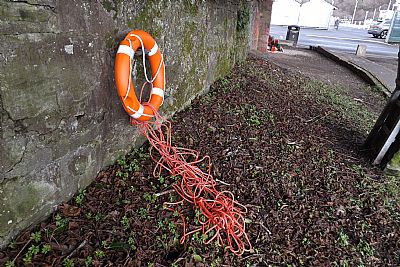
This is one of the lifebelts installed on bridges over the Leven in response to drownings. A great many now float on the river, tangled up in the fallen trees. Few are easily recoverable. A very sad indictment on local delinquents. This one was recovered and placed under Balloch Bridge, pointedly very close to a drowning, its rope a horrible tangle. Within sight, in fact almost nexxt to it, is a family memorial to a young girl who drowned. Within weeks this area was overgrown again.
Yet just beyond it, under the bridge and close by the entrance to Sweeney's Cruises, is a well kept private memorial to a child who drowned at this point.
With the high numbers of drownings in Loch Lomond during the summer of 2021, extra lifebelts were installed along the shore. This was done through the Partnership Approach to Water Safety (PAWS) in conjunction with West Dunbartonshire Council, the Loch Lomond and the Trossachs National Park Authority, Loch Lomond Rescue Boat and Open Water Rescue, the Prevention and Protection division of the Scottish Fire and Rescue Service (who maintain the equipment) and Police Scotland.
As noted above, many were vandalised and thrown into the Leven, some repeatedly if recovered and replaced. The Leven is now littered with lifebelts that have become entangled in overhanging trees or on rocks.
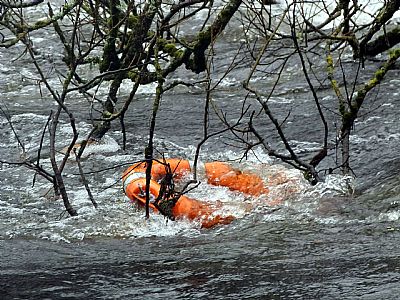
This is one of those lifebelts that have been vandalised and tossed into the river. This photo was taken one November morning. Not a particularly high water, but note how strongly and roughly it flows in some areas. It is the tether rope that usually gets caught on vegetation first.
Rescue
The following photos were taken during rescue exercises on the Leven at the footbridge across from Renton in September 2021 and 2022.
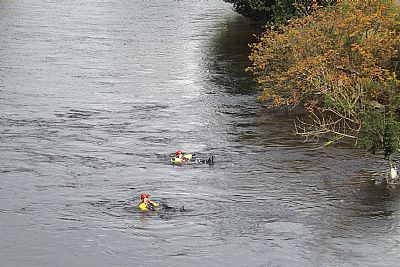
"Victims" get swept downstream by the current,
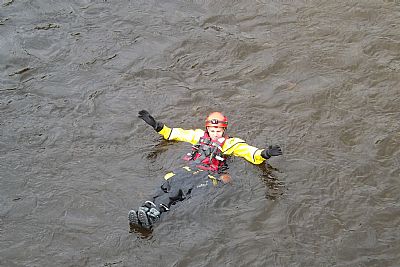
One of the "victims" nears a point from which a rescue attempt can be more easily attempted. You must realise that these crew in the training exercise are well kitted out for the occasion. In reality, the victim will find the water extreme cold at all times of the year and the current can become very turbulent.
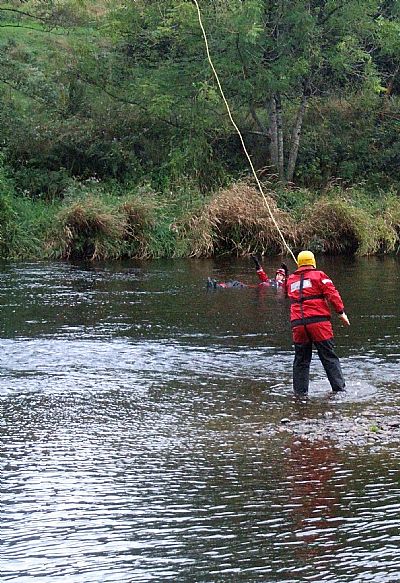
A boyant throw bag is an excellent means of getting a line to a victim.
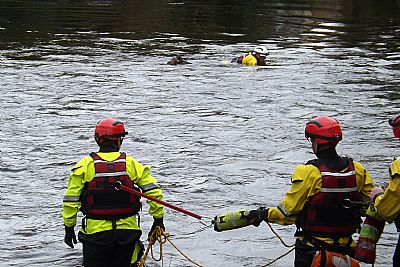
Coordination and communication are key to a successful rescue.
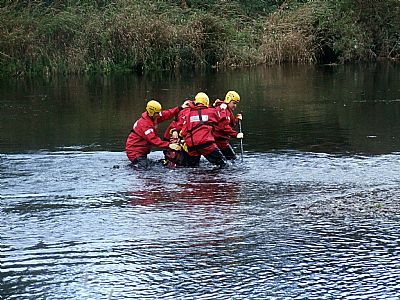
Once pulled in, the team work together to ensure sound footing in the current to carry the victim to safety.
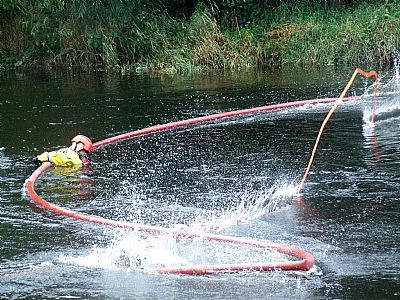
An inflated hose anchored with a rope is used to give a broad grab in fast flowing water.
Prevention - The Danger-Grab-Bouy concept.
While reading this, consider how efficient our rescue services are - if they can be allerted in time and directed to the correct spot. Consider the current as seen in the photo above with the entangled lifebelt. Any delay at all means the victim is dragged downstream fast and far.
If YOU see someone in distress, how would you respond? Could you save someone? Or put yourself in danger too? The following concept aims to warn ahead of a mishap. To prevent it happening in the first place. And if someone finds themselves in distress, gives him or her a possible way to save themselves until someone else manages to get to them.
Water accidents may happen through ignorance. Or misjudgement. Or irresponsibility. It is not our place to be judgemental. Just prevent an incident or save a victim.
A well established range of means of rescue is used by rescue services. Many, perhaps most incidents though, happen very quickly and sometimes in fairly remote areas for suitably prompt reaction by these rescue services and this leaves it up to the public themselves to react. That is why so many lifebelts are installed along the shores of our inland waterways. The new lifebelts are much appreciated within their context, but felt to leave large areas of water just off-shore unprotected. And they require some degree of skill and even means to get them to victims. A suggested option to remedy this is as discussed in the link below; a means of gaining respite when struggling.
Such bouys would :
- mark the edge of underwater shelves which are not just dramatic changes in depth, but also water temperature. Cold water frequently causes cramps.
- mark zones in which boats need to be more cautious such as where swimmers may be.
- provide clear limitations for swimmers away from the shore into boating areas
- provide a means of grabbing onto something if a swimmer gets into diffculty from exhaustion, cramps or simply cold.
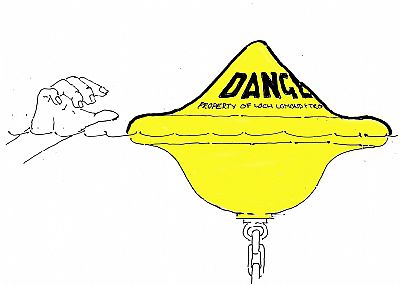
DANGER-GRAB-BUOYS : documents/water-safety/water-safety-on-local-lochs-and-rivers-_danger-grab-buoy-_-a_2.pdf
LOCH LOMOND : index.asp?pageid=715804
HOW TO USE A THROW BAG : https://rnli.org/magazine/magazine-featured-list/2017/june/be-someones-lifeline-know-how-to-use-a-throw-bag https://en.wikipedia.org/wiki/Throw_bag
The RLSS / ROYAL LIFESAVING SOCIETY is very relevant to inland waters : https://www.rlss.org.uk/Pages/Category/water-safety-information
The RNLI / ROYAL NATIONAL LIFEBOAT INSTITUTION have some very notable information more for open waters and the sea : https://rnli.org/
WATER SAFETY SCOTLAND : https://www.watersafetyscotland.org.uk/
WATER SAFETY SCOTLAND'S Drowning Prevention Strategy : https://watersafetyscotland.org.uk/media/1213/scotlands-drowning-prevention-strategy.pdf

